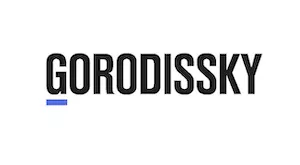Nowadays, within the sector of general merchandise, offer surpasses the needs. Consumers have become more sophisticated. It is getting difficult for manufacturers to attract their attention, to astonish them, to make them choose one's product. Apart from the excellent quality of the goods, the business has to invent the very same trade dress that will conquer consumers' hearts and play into the hands of the producer.
If the created design of a trade dress is unique and authentic, it is reasonable to obtain its protection as an object of intellectual property rights. Russian legislation on intellectual property suggests several options to protect the design: copyright, industrial designs, and trademarks.
A trademark being a designation used to individualize the goods may be an effective tool that a business can utilize to defend the trade dress.
In Russia, a vast list of designations may be registered as trademarks. While Part VI of the Russian Civil Code, which regulates intellectual property rights, provides that words, devices, three-dimensional and other signs or combinations thereof can be registered as trademarks, Regulations for compilation, submission and consideration of documents for state registration of trademarks (hereafter – "Regulations") foresee various other types of marks, including nonconventional ones, such as, for example, holographic marks, positional marks, marks consisting exclusively of one or more colors that may enjoy trademark protection. Thus, business is not bound by a creative approach to individualize their goods and a trade dress may obtain protection as a trademark, for instance, as a three-dimensional trademark.
Generally, a three-dimensional mark represents the shape of the product or its part, the shape of the packaging of the product, and the shape not related to the product. In the aspect of the shape of the product or its packaging, three dimensional marks verge on industrial designs. Therefore, in terms of the examination of a three dimensional mark, the crucial point is to determine its inherent distinctiveness with respect to the applied goods. To establish whether the shape itself is not merely utilitarian, functional, and ordinary, Russian law requires the capability of distinguishing goods of the applicant from similar goods of other traders, i.e., if the shape is peculiar enough for the customers to recognize and select the product of a particular trader exclusively by its form.
Notably, the criteria of functionality and commonness of the shape may be evaluated separately. The following two examples evidence the difference between these two touchstones.
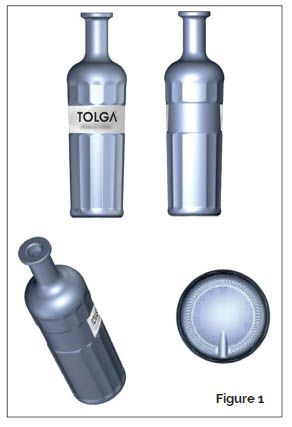
The applicant filed a three-dimensional application for a bottle design Figure 1 covering such goods as alcoholic and non-alcoholic beverages. As a result of trademark examination, the Russian PTO deemed it possible to grant protection to the applied designation with a disclaimer of the form of the bottle from separate legal protection. The examiner reasoned the decision stating that the shape of the bottle was functional and lacked distinctiveness. The applicant disagreed with the said position and appealed the decision of registration with the Chamber of Patent Disputes of the Russian PTO. The applicant argued that the applied form of the bottle had an original design, most of the elements were of a decorative nature, rather than dictated by the need to fulfill a particular function, and besides the applicant already owned an industrial design for the "bottle", which attested to the novelty and originality of the applied shape. However, the Chamber of Patent Disputes and subsequently the IP Court upheld the initial decision of the Russian PTO pointing out the fact that all the features of the applied shape were functional, specifically, they provided comfort when holding the bottle in the hand, its stable position on a flat surface and its convenient use, storage, and transportation; the recess encircling the body of the bottle with a smooth side surface was designed for a snug fit of the label to the body of the bottle. Further, the administrative body and the court dismissed the argument that the existing industrial design served as proof of the originality of the form and thus distinctiveness of the applied designation indicating that trademarks and industrial designs were different objects of intellectual property rights that had different legal regulation and scope of protection.
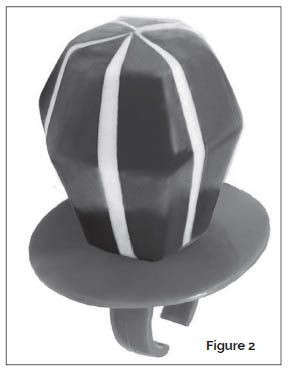
Another case deals with the three-dimensional shape Figure 2 applied for confectionery. The Russian PTO refused registration of the subject designation stating that the form of the ring with the faceted stone lacked distinctiveness as it represented the realistic image of the goods applied for, besides the shape was allegedly used by many manufacturers in the applicant's field of business. The applicant appealed against the official refusal, but the Chamber of Patent Disputes kept the rejection in force indicating in its own decision that all-union state standards for confectionery (that includes various candies and marshmallows) foresaw that those products may be of diverse form and, according to publicly available sources of information, there was a variety of confectionery shapes presented on the market, including the shape of a ring.
As such it is not only the functionality of the form that may lead to the rejection of a three-dimensional designation to be registered as a trademark, but also its common nature that is typical to products of the same kind and that does not impart the designation with the uniqueness, which would provide for its distinctiveness.
It should be noted though that in the latter example for the three-dimensional shape of confectionery, the applicant further appealed the decision of the Chamber of Patent Disputes with the IP court. As a result, the Court dismissed the decision of the administrative body and imposed the Russian PTO to register the applied designation in relation to the applied goods. It was indicated in the judgment that a comparison of the applied designation to a variety of confectionery shapes presented on the market did not prove that the applied designation represented a standard form of the product; besides the materials of the case did not evidence that the shape applied for was functional for the applied goods (confectionery). So, the estimation of the distinctiveness of a three-dimensional form applied to be registered as a trademark has a somewhat subjective character, and the opinion of the administrative body and the judicial one do not always coincide.
Actually, the approach of the Russian PTO in the evaluation of the distinctiveness of three dimensional marks is not that obvious.
THOSE DESIGN FEATURES WERE THE CENTRAL ELEMENT AND MAIN ATTENTION TO THE CUSTOMERS AND CREATED A NEW MEMORABLE IMAGE OF THE PRODUCT.
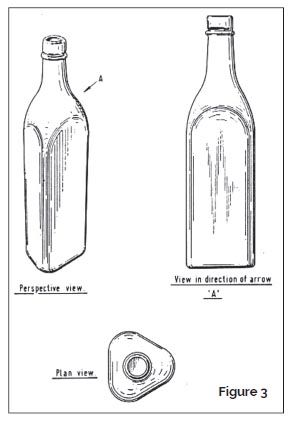
For instance, an invalidation action was initiated by an interested person against the trademark Figure 3. The claimant stated that the registration of the mark was made in violation of the provisions of the law as the shape of the bottle was merely functional and was made of simple geometrical figures. The trademark holder presented arguments in defense of the originality of the form and additionally submitted the results of the opinion poll, which evidenced that the consumers recognized the shape of the bottle to be original, untypical for alcoholic beverages, and known as a trademark of the holder. The Chamber of Patent Disputes of the Russian PTO indicated in its decision that the memorable original shape of the bottle directly affected its general external outlines. Those design features were the central element and main attention to the customers and created a new memorable image of the product, besides the Russian PTO did not find the shape to be functional. As a result, the registration of the disputed trademark was kept in force.
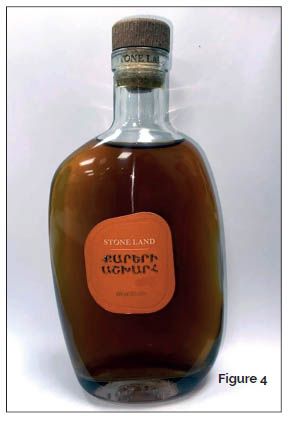
At the same time, the Russian PTO decided to grant protection to the designation of Figure 4 in respect of alcoholic beverages with a disclaimer of the shape of the bottle. The examiner opined that the form was functional and lacked distinctiveness. In the present case, the applicantfiled the appeal against the office action which presented arguments in favor of the untypical shape of the bottle that resembled a stone, and submitted materials, including the results of the opinion poll, as proof of fame and awareness of the applied designation for such goods as "brandy". Having considered the materials of the case, the Chamber of Patent Disputes came to the conclusion that the applied designation might be registered as a trademark without a disclaimer of the form of the bottle for specific goods (i.e., brandy) as it has acquired distinctiveness through its intensive use.
As it goes from the provided examples, the question of the distinctiveness of the shape of a three-dimensional mark is quite complicated and controversial. That being said, unless a three-dimensional designation represents an extraordinary design that is not typically used for such a product or a package, there is a risk that such a mark may face a lack of distinctiveness objection. What is more, even if the mark obtains protection, it may be challenged by an interested person within the whole term of validity on the basis of a lack of distinctiveness ground, which was the case with a three-dimensional mark featuring the shape of a golden-colored package designed for food products (Figure 5).
TO ESTIMATE THE CHANCES OF OBTAINING PROTECTION OF A SHAPE AS A TRADEMARK, IT IS ADVISABLE TO REVIEW THE SO-CALLED ANALOG RANGE OF FORMS HAVING SIMILAR PURPOSES IN ORDER TO REVEAL COMMON FEATURES OF SUCH SHAPES.
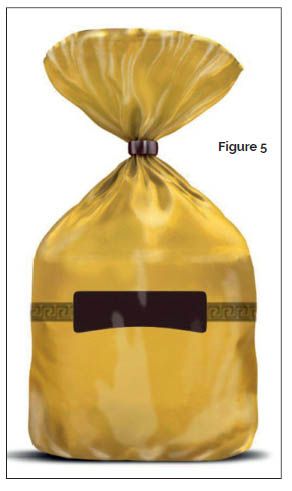
The mark was registered subject to a disclaimer of the design of the shape. Subsequently, the mark was invalidated by a third party based on a lack of distinctiveness. The invalidation action was based on the fact that the non-protected elements of the mark, namely the shape design and the golden color of the package occupied a dominant position in the mark and therefore the mark should be considered non-distinctive as a whole.
The brand owner did not agree with the invalidity decision issued by the Chamber of Patent Disputes of the Russian PTO and tried to appeal the decision with the IP Court. The latter, however, upheld the position of the Russian PTO and pointed out the fact that the proposed shape design mark was not entitled to protectionas the dominating elements of the mark, namely the shape design and the golden color, lacked distinctive character whereas additional elements of the mark could not change the overall impression created by the mark when viewed as a whole. The court also claimed that the brand owner failed to submit evidence of acquired distinctiveness specific to the mark as applied. Thus, the invalidity decision remained in force.
Judging from the recent cases on three-dimensional marks, one can notice that there is no universal approach to determine the distinctiveness of three-dimensional marks. Each case is studied and analyzed separately and in a set of various factors. To estimate the chances of obtaining protection of a shape as a trademark, it is advisable to review the so-called analog range of forms having similar purposes in order to reveal common features of such shapes. If the range is vast, then even slight differences from the ordinary features should be considered as being sufficient to generate distinctiveness of the form. If chosen wisely, a shape may become a haunting three-dimensional mark that will contribute to business development and perfectly function as a means of individualization.
The content of this article is intended to provide a general guide to the subject matter. Specialist advice should be sought about your specific circumstances.
